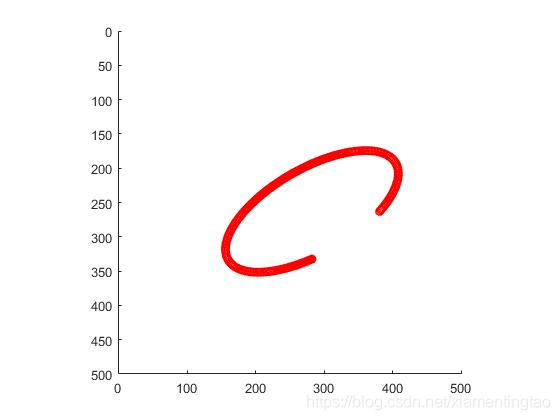圓上任意角度的點的坐標

如上圖,給定圓心(Cx,Cy),半徑為R, 求θ\thetaθ對應的點的坐標? 此處θ\thetaθ是相對于水平軸的角度。
顯然我們可以使用極坐標轉換來求:
{px=Cx+Rcos(θ)py=Cy+Rsin(θ)\left\{\begin{matrix} px= Cx+Rcos(\theta) \\ py= Cy+Rsin(\theta) \end{matrix}\right. {px=Cx+Rcos(θ)py=Cy+Rsin(θ)?
注意如果以上豎直坐標系向下,此時變為圖像的坐標系,即

結果變成:
{px=Cx+Rcos(θ)py=Cy?Rsin(θ)\left\{\begin{matrix} px= Cx+Rcos(\theta) \\ py= Cy-Rsin(\theta) \end{matrix}\right. {px=Cx+Rcos(θ)py=Cy?Rsin(θ)?
僅僅是y變了。
橢圓上任意角度的點的坐標
首先我們先來考慮標準橢圓上任意角度的點的坐標,再進行推廣。

已知主軸a(即橢圓箭頭所指方向對應的軸),次軸b,求解與水平軸相交θ\thetaθ對應的點的坐標?
{x2a2+y2b2=1yx=tan?(θ)\left\{\begin{matrix} \frac{x^2}{a^2}+\frac{y^2}{b^2}&=&1 \\ \frac{y}{x}& =& \tan(\theta) \end{matrix}\right. {a2x2?+b2y2?xy??==?1tan(θ)?
將上面的第二式帶入第一式,可以求解得到:
x2=a2b2b2+a2tan?2(θ)x^2=\frac{a^2b^2}{b^2+a^2\tan^2(\theta)} x2=b2+a2tan2(θ)a2b2?
這時我們考慮θ\thetaθ的范圍,可以得到:
(一). 0≤θ<pi/20\leq\theta<pi/20≤θ<pi/2 或者 3?pi2<θ≤2?pi\frac{3*pi}{2}<\theta \leq 2*pi23?pi?<θ≤2?pi
{x=abb2+a2tan?2(θ)y=abtan?(θ)b2+a2tan?2(θ)\left\{\begin{matrix} x=\frac{ab}{\sqrt{b^2+a^2\tan^2(\theta)}} \\ y=\frac{ab\tan(\theta)}{\sqrt{b^2+a^2\tan^2(\theta)}} \end{matrix}\right. ????x=b2+a2tan2(θ)?ab?y=b2+a2tan2(θ)?abtan(θ)??
(二). pi/2<θ<3?pi2pi/2<\theta<\frac{3*pi}{2}pi/2<θ<23?pi?
{x=?abb2+a2tan?2(θ)y=?abtan?(θ)b2+a2tan?2(θ)\left\{\begin{matrix} x=-\frac{ab}{\sqrt{b^2+a^2\tan^2(\theta)}} \\ y=-\frac{ab\tan(\theta)}{\sqrt{b^2+a^2\tan^2(\theta)}} \end{matrix}\right. ????x=?b2+a2tan2(θ)?ab?y=?b2+a2tan2(θ)?abtan(θ)??
(三). θ=pi/2\theta = pi/2θ=pi/2
{x=0y=b\left\{\begin{matrix} x=0 \\ y=b \end{matrix}\right. {x=0y=b?
(四). θ=3?pi2\theta = \frac{3*pi}{2}θ=23?pi?
{x=0y=?b\left\{\begin{matrix} x=0 \\ y=-b \end{matrix}\right. {x=0y=?b?
再考慮一般情況下的橢圓,如下:

如上θ∈[0,2?pi]\theta\in[0,2*pi]θ∈[0,2?pi]是相對于主軸的角度,α∈[?pi,pi]\alpha\in[-pi,pi]α∈[?pi,pi], 不過我們一般僅僅考慮α∈[0,pi]\alpha\in[0,pi]α∈[0,pi],求θ\thetaθ對應的點的坐標?
基本思路就是先轉換成標準橢圓,再應用標準橢圓下的結果。
顯然我們需要將以上橢圓的中心移到原點,再繞原點旋轉?α-\alpha?α ,即順時針旋轉α\alphaα,即:
(xy)=R((XY)?(XcYc))\begin{pmatrix} x\\ y \end{pmatrix}=R(\begin{pmatrix} X\\ Y \end{pmatrix}-\begin{pmatrix} X_c\\Y_c \end{pmatrix}) (xy?)=R((XY?)?(Xc?Yc??))
其中
R=(cos(?α)?sin(?α)sin(?α)cos(?α))=(cos(α)sin(α)?sin(α)cos(α))R=\begin{pmatrix} cos(-\alpha) &-sin(-\alpha) \\ sin(-\alpha) & cos(-\alpha) \end{pmatrix}=\begin{pmatrix} cos(\alpha) &sin(\alpha) \\ -sin(\alpha) & cos(\alpha) \end{pmatrix} R=(cos(?α)sin(?α)??sin(?α)cos(?α)?)=(cos(α)?sin(α)?sin(α)cos(α)?)
因此
(XY)=R?1(xy)+(XcYc)\begin{pmatrix} X\\ Y \end{pmatrix} =R^{-1}\begin{pmatrix} x\\ y \end{pmatrix}+\begin{pmatrix} X_c\\Y_c \end{pmatrix} (XY?)=R?1(xy?)+(Xc?Yc??)
其中
R?1=RT=(cos(α)?sin(α)sin(α)cos(α))(★)R^{-1}=R^{T}=\begin{pmatrix} cos(\alpha) &-sin(\alpha) \\ sin(\alpha) & cos(\alpha) \end{pmatrix}~~~~~~~~~~~~~~~~~~~~~~~~~~~(\bigstar) R?1=RT=(cos(α)sin(α)??sin(α)cos(α)?)???????????????????????????(★)
這樣將前面(xy)\begin{pmatrix} x\\ y \end{pmatrix}(xy?) 的四個結果應用過來,即得到傾斜的橢圓上的對應角度的點的坐標。
擴展:
- 如果以上的角度是相對于水平軸的角度,則對應的橢圓上的點的坐標如何求呢?
答: 其實很簡單,只需要:
θ′={θ?α+2?pi,θ<αθ?α,θ≥α\theta'=\left\{\begin{matrix} \theta-\alpha+2*pi, & \theta<\alpha \\ \theta-\alpha, & \theta \geq \alpha \end{matrix}\right. θ′={θ?α+2?pi,θ?α,?θ<αθ≥α?
將θ′\theta'θ′替換以上標準橢圓下的θ\thetaθ即可。 - 如果豎直坐標軸為豎直向下的,即為圖像坐標系下的橢圓,那么如何求對應的角度?
答:
需要做兩方面的改變即可:
{α→?αy→?y\left\{\begin{matrix} \alpha\rightarrow -\alpha\\ y\rightarrow -y \end{matrix}\right. {α→?αy→?y?
第一行改變★\bigstar★出的α\alphaα. 第二行改變標準橢圓下的y值的符號。
matlab代碼
demo.m
################################
center_x=282;
center_y=263;
phi=pi/6;
R1=141;
R2=62;
%DrawEllipse([center_x,center_y],R1,R2,phi);
axis equal;
hold on;
set(gca,'ydir','reverse')
for angle=linspace(0,3*pi/2,360)[ px,py ] = get_points_ellipse(center_x, center_y,phi,R1,R2, angle );plot(px,py,'ro');hold on;
end
axis([0,500,0,500])
function [ px,py ] = get_points_ellipse(center_x, center_y,phi,R1,R2, angle )
% 求橢圓某個角度上的點的坐標。
%https://math.stackexchange.com/questions/22064/calculating-a-point-that-lies-on-an-ellipse-given-an-angle
%https://blog.csdn.net/xiamentingtao/article/details/54934467%https://stackoverflow.com/questions/17762077/how-to-find-the-point-on-ellipse-given-the-angle
%另一種解法 從極坐標的角度出發。% 橢圓參數 圓心 (center_x.center_y) 角度 phi(-pi,pi),實際上僅考慮(0,pi) 沿著角度的主軸半徑R1,另一主軸對應的半徑R2
% 求相對于水平軸x軸上angle(基于0-2pi之間)上對應的點坐標。
% 注意求解的坐標系為:水平向右為x軸,豎直向上為y軸。 如果豎直向下為y軸,則下面的y應該變換成-y, phi變成-phi%先將斜的橢圓轉正,并平移到原點。方法就是平移到中心,且旋轉-phi角度,再應用標準橢圓求取點。
if(angle<phi)theta = angle-phi+2*pi; %想對于主軸的角度
elsetheta = angle-phi;
end
% theta為相對于主軸的角度
alpha = -phi; %與豎直的軸有關,如果是豎直向上,則變為正phi
% 先計算標準橢圓 x^2/R1^2+y^2/R2^2=1 與 直線 y/x=tan(angle)的交點。
assert(angle>=0 && angle<=2*pi);
if(theta==pi/2)x=0;y=R2;
elseif(theta==pi*3/2)x=0;y=-R2;
elseif(theta>pi/2 && theta<pi*3/2)x=-R1*R2/sqrt(R2^2+R1^2*tan(theta)^2);y=-R1*R2*tan(theta)/sqrt(R2^2+R1^2*tan(theta)^2);
elsex=R1*R2/sqrt(R2^2+R1^2*tan(theta)^2);y=R1*R2*tan(theta)/sqrt(R2^2+R1^2*tan(theta)^2);
endy=-y; %與豎直的軸有關,如果是豎直向上,則變為正y
% 將以上結果轉換回去
px= cos(alpha)*x-sin(alpha)*y+center_x;
py=sin(alpha)*x+cos(alpha)*y+center_y;endfunction DrawEllipse(C,a,b,alpha)
% DRAWELLIPSE plots an ellipse
% DrawEllipse(C,a,b,alpha) plots ellipse with center C, semiaxis a
% and b and angle alpha between a and the x-axiss=sin(alpha); c=cos(alpha);
Q =[c -s; s c]; theta=[0:0.02:2*pi];
u=diag(C)*ones(2,length(theta)) + Q*[a*cos(theta); b*sin(theta)];
plot(u(1,:),u(2,:));
hold on;
plot(C(1),C(2),'+');顯示結果,起點對應著角度為0。

另一種基于極坐標變換的高效實現【轉載】
轉載: https://blog.csdn.net/he_zhidan/article/details/81347426
根據“圓心角”弧度(函數會將圓心角轉成離心角),獲取斜橢圓上的點坐標。ptCenter,橢圓中心;a橢圓長軸長度;b,橢圓短軸長度;radian,點于橢圓長軸夾角的弧度;dChangZhouAngle,長軸弧度
CDoublePoint2d GetPointOnEllipse(const CDoublePoint2d& ptCenter, double a, double b, double radian, double dChangZhouAngle)
{
const double dLiXin = atan2(asin(radian), bcos(radian));//離心角
double x = a*cos(dLiXin)cos(dChangZhouAngle) - bsin(dLiXin)sin(dChangZhouAngle) + ptCenter.x;
double y = acos(dLiXin)sin(dChangZhouAngle) + bsin(dLiXin)*cos(dChangZhouAngle) + ptCenter.y;
return CDoublePoint2d(x, y);
}
問題:
一,為什么不用atan?
答:atan的范圍是[-π/2,π/2],atan2的范圍是(-π,π]。前者只能表示兩個象限,后者可以表示4個。
二,為什么不atan2(a*tan(radian),b)?
答:這樣寫,和用atan的效果一樣。
參考文獻
- https://math.stackexchange.com/questions/22064/calculating-a-point-that-lies-on-an-ellipse-given-an-angle (主要參考這個)
- https://stackoverflow.com/questions/17762077/how-to-find-the-point-on-ellipse-given-the-angle (這里有一個從極坐標變換角度新的推導)
- https://blog.csdn.net/xiamentingtao/article/details/54934467



















